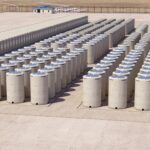Suzuki’s Fukushima updates
By Tatsujiro Suzuki | February 22, 2014
FEBRUARY 21, 2014 – The Tokyo Electric Power Co (Tepco) reported that the workers at the Fukushima Daiichi nuclear power plant discovered and stopped water overflow from one of its storage tanks for contaminated water.
Tepco says that its overflow was believed to be caused by the unplanned flow of water through a pipe from the processing facility to the tank, designated as C1. According to Tepco, there are three valves on the pipe, of which two were improperly left open, and the other was closed but failed to function. The two open valves were shut by workers at approximately 1:30 am on February 20, halting the overflow. TEPCO is continuing to investigate the reasons why the valves were open, and why the closed valve was not functioning.
The report says that about 100 tons of water was released, but there is no pathway leading from that area to the sea, which is approximately 700 meters away, and none of the overflow is believed to have reached the ocean. Test results for the overflow water showed as much as 230 million becquerels per liter, which is roughly 8 million times the regulatory standard.
Responding to the report from Tepco, the Nuclear Regulatory Authority (NRA) issued its recommendations for Tepco, saying the company should: take measures to stop the water leakage promptly; determine the scope of the area contaminated by the leaked water; figure out the total amount of leaked water and the concentration of radioactive materials in the water; remove contaminated soil to a storage place on site; and check whether water is leaking from other tanks of the same type as C1.
###
FEBRUARY 13, 2014 –The Tokyo Electric Power Co (Tepco) has published new results of water samples taken from monitoring wells on the east (sea) side of the Fukushima Daiichi nuclear power plant.
One of the samples taken from a new well, located about 50 meters from Unit 2, showed 54,000 becquerels per liter of water of cesium 137 and 22,000 becquerels per liter of cesium 134. The concentration of cesium 137 was about 600 times the regulatory standards for water released to the sea. Tepco says it suspects that contaminated water is leaking from the tunnel that connects the Unit 2 building and the sea.
###
FEBRUARY 7, 2014 – On February 6, the Tokyo Electric Power Co. (Tepco) published new monitoring results of water samples taken from wells on the east (sea) side of the Fukushima Daiichi nuclear power plant.
One of the results, water taken from a well near Unit 1, showed an extraordinarily high concentration of strontium 90, i.e. five million becquerels per liter. This water sample was taken on July 5, 2013; Tepco previously reported that the result was 900,000 becquerels per liter, but it has been re-assessed since then because Tepco believed this initial measurement was too high to be regarded as accurate. But now, Tepco has admitted that the measurement was actually much higher than previously published. Tepco did not report this data until yesterday. The regulatory standard for underground water is 5,100 becquerels per liter, about one-thousandth of the monitored result. Tepco suspects that this high concentration was caused by the accidental release of highly contaminated water during the accident in March 2011.
###
FEBRUARY 6, 2014 – On February 5, 2014, the Nuclear Regulatory Authority (NRA) published its latest report on the status of the Fukushima Daiichi nuclear power plant.
In the report, the NRA confirmed that by January 31, the Tokyo Electric Power Co. (Tepco) had removed a total of 264 fuel assemblies (including 22 new fuel assemblies) from the storage pool for Unit 4 and transferred them to a common storage pool on the ground nearby. Tepco plans to transfer total of 1,533 fuel assemblies from Unit 4 to the common storage pool by the end of 2014.
The NRA conducted an independent survey of its operation and found high radiation levels measuring 81 microsieverts per hour above the fuel handling machine and 90 microsieverts per hour above the operation floor at Unit 4. The NRA also found that radiation levels can be reduced to about one third that level (90 to 33 microsieverts per hour) by installing a lead wall or floor above the Unit 4 storage pool as a shield against radiation. The NRA believes that this high-level radiation may be caused by cobalt 60 contamination in the storage pool, which might have been released during fuel handling before the disaster of March 11, 2011. The NRA recommended that Tepco take appropriate measures to reduce radiation exposure of workers at Unit 4.
On February 3, Tepco announced new standards for releasing underground water to the open sea; until now, this water has been pumped from wells and stored in tanks on site. The underground water is pumped before it flows into the lower levels of reactor buildings and therefore is not believed to be heavily contaminated. But so far the utility is not allowed to release this water to the sea due to concern from the local fishing industry. Tepco has set stricter than regulatory standards for total beta measurements (five becquerels per liter of water, rather than the regulatory limit of 10 becquerels) and tritium (1,500 becquerels per liter rather than 30,000 becquerels). The company has adopted standards for cesium 134 and cesium 137 that are the same as the government's regulatory standards of one becquerel per liter for each isotope. Japanese media report that the Ministry of Economy, Trade, and Industry has conveyed these new standards to the National Federation of Fisheries Cooperative Associations and is hoping that they are low enough for the fishing industry to accept.
###
On January 18, 2014, a Tepco worker found that water was leaking to drainage in the vicinity of the unit's main steam isolation valve, according to the press release. The water seems to be flowing from the containment vessel and into the basement of the reactor building. Tepco also found that the water is contaminated (from cesium-134, 700 becquerel per cubic centimeter of water; from cesium-137, 1,700 becquerel per cubic centimeter of water; and from cobalt-60, 25 becquerels per cubic centimeter of water). The temperature of the water—20 degrees Celsius or 68 degrees Fahrenheit—is also warmer than the natural ground water, which measures 7 degrees Celsius or about 45 degrees Fahrenheit. Tepco reported that the water seems not to be leaking into the environment, as there has been no significant increase in radiation detection in the area. Also, the Unit 3 reactor continues to be steadily cooled, the company said.
The leakage is a significant finding; it could indicate that the Unit 3 containment vessel has significant damage and cooling water is leaking from it. Tepco said that it will continue to investigate the cause and location of the leak. Tepco's monitoring video of the leak is posted here.
Tepco has also issued a new plan for victim compensation, recovery of Fukushima prefecture, and reorganization of the company itself. It calls for an establishment of a new company exclusively dedicated to decommissioning of Fukushima Daiichi nuclear power plant. It is expected to improve financial and technical capabilities.
###
NOVEMBER 15, 2013—The Nuclear Regulatory Authority (NRA) issued a statement yesterday on the Tokyo Electric Power Company’s plans to remove spent fuel from unit 4 at the Fukushima Daiichi Nuclear Power Station.
During the week of November 18, Tepco, as the company is known, will begin to remove a total of 1,533 fuel assemblies (1,331 assemblies of spent fuel and 202 of fresh fuel) from unit 4’s storage pool. This fuel will then be transferred to a common pool for temporary storage. The entire process will take about a year and the NRA expects the effort to be completed by the end of 2014. Tepco also reported three out of 1,533 fuel assemblies are damaged and that it may not be possible to remove those fuel assemblies under the current plan.
The authority provided Tepco with three regulatory requirements for the planned removal. The first is to maintain the subcritical condition of the nuclear fuel. The second, the authority emphasized, is to take measures to prevent the assemblies from being mishandled or dropped and to mitigate the radiation effects to the environment. The NRA’s final requirement, it stated, is to cool the removed fuel and to store the fuel in appropriate conditions.
In August of this year, the authority approved Tepco’s implementation plan to remove spent fuel from unit 4, but the NRA requested that elements of the plan be improved upon and revised, including the methods of fuel-integrity assessments. The NRA approved the plan on October 30.
On November 13, Tepco released the updated implementation plan, which was reviewed and approved by an international expert group after an on-site examination by Lake Barrett, a former member of US Nuclear Regulatory Commission who led the cleanup efforts after the accident at Three Mile Island in the United States. Barrett is now advising Tepco’s president on the clean up.
###
OCTOBER 26, 2013—On October 23, the Tokyo Electric Power Company (Tepco) sampled water at a drainage channel at the Fukushima Daiichi Nuclear Power Station. One of these water samples, collected about 600 meters from the outer sea, showed that the total beta-ray radioactivity was at its highest concentration level yet: 140,000 becquerel per liter, compared with 59,000 becquerel per liter at the same place on October 22. Though the causes of this high concentration remain unknown, Tepco suspects it was due to more heavy rains that fell over the past week.
Tepco also reported to the Nuclear Regulatory Authority on October 24 that it will take extra measures to prevent further water overflow—for example, by building taller barriers and installing water drainage channels at the top of the tanks. Tepco also said it will drain excess water into the sea only if the levels are within health and safety standards—below 15 becquerel per liter for cesium 134; 25 becquerel per liter for cesium 137, and 10 becquerel per liter for strontium 90—as an emergency measure to minimize overflow of highly contaminated water. The company has never done this before, but the authority has approved such measures in order to reduce the risk that highly contaminated water will overflow from the tanks and into the ocean.
Collecting from a different sea location near the site —about 1.1 kilometers (0.68 miles) from the water outlet for nuclear reactors (outside the plant site)—the Nuclear Regulatory Authority reported that it did not find significant increases in the concentration of cesium 134 and 137, or the total beta radioactivity.
###
OCTOBER 19, 2013—On October 18, Tepco updated its water-sample analysis, which it had announced the day before, on October 17. The company found the water tank—which had leaked about 300 tons of contaminated water on August 19—to contain 790,000 becquerel per liter of tritium and 400,000 becquerel per liter of total beta-ray radioactivity. In contrast, the samples taken at the same place on October 16 showed 230,000 becquerel per liter of tritium and 61 becquerel per liter of beta-ray radioactivity. The sources of this high-level contamination remain unknown, but Tepco said it will continue to examine the possible causes.
###
OCTOBER 18, 2013—On Thursday, October 17, Tepco released new analysis of water samples obtained from where water leaks sprang on August 19 and on October 2. The company found the total level of all beta-ray radioactivity to be significantly higher on these dates compared to earlier dates. The highest level was 2,300 becquerel per liter on October 16; this is significantly higher than the regulatory standard of 30 becquerel per liter. At a test point 150 meters from the sea, the beta radioactivity level measured 1,400 becquerel per liter, while it was only 19 becquerel per liter on October 15. This is a source of concern; if the water leak is not contained successfully, the contaminated water could drain into the outer sea.
Tepco explained that these recent floods—water that likely contained contaminated soil matter—caused this increased level of radioactivity.
On Wednesday, October 16, Typhoon Wipha hit the east coast of Japan, including yet again the Fukushima Daiichi Nuclear Power Station plant; this is the twenty-sixth typhoon this year. The next day at 7:40 a.m., an employee of the Tokyo Electric Power Company (Tepco) discovered via webcam that water was overflowing out of a temporary tank, which stored contaminated groundwater. Tepco also found that the man-made dike (constructed around the temporary tank) had collected the water and, as designed, redirected the water back to the well points. Thus, Tepco ruled out the possibility that the contaminated water seeped into the surrounding soil or sea.
###
OCTOBER 14, 2013—On October 9, the Tokyo Electric Power Company (Tepco) announced that at 9:35 that morning about 7 cubic meters of water leaked from a pipe joint in the desalination system, which sits inside a temporary warehouse.
Tepco confirmed that the contaminated water flowed into a ditch, which had been constructed inside the warehouse. According to the company, the leak was caused by human error: Workers, apparently, mistakenly removed the wrong pipe of the desalination system. The decontamination system had already removed cesium from the water; however, the water had not been desalinated yet.
Tepco also reported that out of eleven workers who were working in the warehouse, six workers had radioactive materials on their bodies. The company announced that no materials were detected on the faces of these six workers; thus, it ruled out the possibility of internal intake of radioactive material.
On October 10, Tepco announced that it had detected a small amount of cesium 137 in seawater 1 kilometer from the Fukushima Daiichi Nuclear Power Station. The company also reported that it had discovered a significant increase in cesium 134 and 137 in the water-intake area at unit 2. The company found the leaked water to contain 390 becquerel per liter of cesium 134; 1,300 becquerel per liter of cesium 137; and a total of 34 million becquerel per liter of all beta radioactivity, including strontium—beta particles are less penetrative than the more serious and energetic gamma rays. By comparison, the cesium 134 measurements the day before, on October 9, were 370 becquerel per liter and 26 becquerel per liter on October 8; cesium 137 measurements were 830 becquerel per liter on October 9 and 64 becquerel per liter on October 8. These measurements exceed the regulatory limits placed on cesium 134 and 137, which are set at 90 becquerel per liter for waste water and are set at 10 becquerel per liter for drinking water. Tepco said that the ground improvement work near unit 2’s water-intake area may have caused this increase; however, this has not been confirmed and the actual causes remain unknown. Outside this area, no other significant increases were detected. Both Tepco and the Nuclear Regulation Authority are investigating this event.
###
OCTOBER 7, 2013—On October 2, another typhoon hit the Fukushima area, bringing in even more rainfall; consequently, the Tokyo Electric Power Company (Tepco) tried to redirect the rainwater to prevent the above-ground contaminated water tanks from overflowing. Tepco’s attempt, however, was not successful, and the company discovered that contaminated water had indeed leaked from a tank—but in a different area from the one where the previous leak had been found in August of this year. The new leak was found in "B area South," an area slightly south of the original leak and an area that is sloped, which means that the water tank is not horizontal; that is, this 1.4 percent slope—a 13-centimeter difference in height—is higher than the 1 percent slope that Tepco voluntarily set for the storage tanks. Thus, the company’s workers could not see that the tank was already full when they transferred water from the dyke to the tank.
Tepco estimated that approximately 430 liters, or 0.43 tons, of water overflowed into the drainage system; this amount is much smaller than the previous 300-ton leak, which was the estimate reported in August.
Tepco cannot deny the possibility that the water that leaked into the drainage channel could have flowed out into the ocean. The company placed sandbags at a side ditch to prevent further water leakage into the drainage system.
Taken at 7 a.m. on October 3, the analysis of seawater samples around the drainage channel showed that beta radioactivity measurements were 20 becquerels per liter; cesium 134 measurements were 1.5 becquerels per liter; and cesium 137 measurements were 1.2 becquerels per liter. All measurements were below the detection limit, which suggests that the environmental and health impacts of the leak are not significant.
###
SEPTEMBER 28, 2013—On September 25, the Tokyo Electric Power Company (Tepco) discovered two possible holes at the bottom of the tank, from where 300 tons of contaminated water supposedly leaked in August. The company suspects that the water may have leaked from spaces found between the bolts and the wall of the tank, which measures 12 meters wide and 10 meters high. Tepco said the bolts were not loose.
On September 26, Tepco found that the silt fence—intended to block the water from the plant from flowing into the open bay area—was broken near units 5 and 6. The next day, on September 27, Tepco reported that the fence was replaced. The company found no significant increase in radioactivity levels near the bay area (the highest level of cesium concentration was 7.4 bequerels per liter).
On September 27, the ALPS (Advanced Liquid Processing System), which is designed to remove most of the radioactive nuclides except tritium, started its “hot test”—that is, the facility used radioactive materials during the test-run operation.
###
SEPTEMBER 18, 2013—On September 15 and 16, Typhoon Man-yi struck the main island of Japan, while strong winds and a huge amount of rainfall hit the Fukushima area. After the typhoon hit on September 15, Tepco sampled water from surrounding tanks and found that the highest contamination level of tritium was 170,000 becquerels per liter—about three times the regulatory standard of 60,000 becquerels per liter of tritium. For example, before the typhoon, the highest contamination level had been found on September 8, when the reading hit 4,200 becquerels per liter; however, since then—due to reasons still unknown—the levels had been steadily climbing to 64,000 becquerels per liter on September 10, and 130,000 becquerels per liter two days later.
On September 17, Tokyo Electric Power (Tepco) announced the status of the contaminated water tanks, as well as the state of the water leakage. Typhoon Man-yi not only had wind gusts of more than 160 kilometers per hour, but the rainfall was double that of the area’s annual rate. Due to such heavy rain, Tepco found that some of the water barriers, standing about 30 centimeters tall around the storage tanks, were close to overflowing. Thus, the company decided to drain the contaminated water that was lower than the regulatory standard. The highest contamination level of mostly strontium 90 was 24 becquerels per liter, which is lower than the regulatory standard of 30 becquerels per liter of strontium 90. Tepco drained into the ground a total of 1,130 tons of water from seven tanks, and it is suspected that some of the water may have leaked into the sea. As for the contaminated water above the regulatory standard that was found inside the water barrier, Tepco pumped it into storage tanks to avoid overflow.
On September 17, Tepco released an English-language video explaining the situation at the Fukushima Daiichi Nuclear Power Station.
###
SEPTEMBER 16, 2013—As there are increasing concerns about the safety of the fishery products due to the leak of contaminated water from the Fukushima Daiichi Nuclear Power Station, it is a good time to look at the latest monitoring results provided by the Fisheries Agency. To keep these new numbers in perspective, however, it is useful to recall that on April 1, 2012, Japan lowered the limits of radioactive contaminants acceptable in food, including seafood, to 100 becquerels per kilogram; this new standard for fisheries replaced the provisional regulation value for radioactive cesium, which had been set at 500 becquerels per kilogram.
As of the end of August 2013, Japan had collected a total of 37,470 fish samples—14,070 of which were from Fukushima Prefecture. The tests concluded that 92.6 percent of the samples from Fukushima were below the limit of 100 becquerels per kilogram. From outside the prefecture, 98 percent of the tests were below the standard. The percentage of samples beyond the standard was much higher two years ago. That is, from April to June 2011, Fukushima Prefecture saw 53 percent of its fish samples test positive for radioactive contaminants above the standard limit of 100 becquerels per kilogram; however, this rate has steadily declined to only 2.7 percent during the period from July to August of this year. For samples from outside the Fukushima Prefecture, such percentage was much lower. It was 6.5 percent during the period from March to June 2011, but it has stayed below 1 percent since October 2012; and today, it is around 0.4 percent.
###
SEPTEMBER 9, 2013—Note: On Friday, September 6, I wrote that the radiation level that was detected near the tanks was 2,200 millisieverts per hour. To clarify, this is the exposure within 5 centimeters of the spot where the reading was taken; because much of this is beta radiation—which can be blocked by clothing, for example—exposure drops as one moves away from the radiation source. In fact, from 50 centimeters away, the measurement was 40 millisieverts per hour.
Over the weekend, Japanese Prime Minister Shinzo Abe assured the International Olympic Committee that the “situation [at the Fukushima Daiichi Nuclear Power Station] is under control,” and that the contaminated water is “completely contained” within a 0.3 square kilometer area from the nuclear power station. The technical basis of his statement is as follows:
- There are 32 radiation monitoring stations and 85 radiation monitoring points along the coast of the Fukushima, Ibaraki, and Chiba prefectures. The Nuclear Regulatory Authority reports that the seawater contains 0.021 becquerel per liter or less of cesium 134 and cesium 137—far below the acceptable standard of 10 becquerel per liter.
- The contaminated water is limited to the area around the port near the Fukushima Daiichi Nuclear Power Station—an area that is no larger than 0.3 square kilometers.
- The annual radiation exposure from food and water is estimated to be lower than 0.01 millisieverts.
SEPTEMBER 6, 2013—I have received encouraging feedback and questions to the first column, and would like to express my sincere thanks for your kind support; please excuse me for not responding to those directly through email, Twitter, or Facebook. I will try to respond to your questions in my updates.
###
SEPTEMBER 5, 2013—Given the increased concern over the contaminated water leak at the Fukushima Daiichi Nuclear Power Station, I will resume my online column to provide frequent updates of the situation at Fukushima.
As the Ministry of Economy, Trade, and Industry (METI) summarizes, the events at the Fukushima Daiichi station picked up again on June 19, 2013, when Tepco announced that groundwater was contaminated with radioactive materials in the area between the turbine buildings and the plant port. The next month, on July 22, some of this contaminated water seeped into the plant port, though the radioactive materials that were found there and in the ocean were below the detection limit. Nevertheless, the Ministry announced that countermeasures be imposed, including the removal of the contamination source; isolation of the ground water from the contamination source; and overall leak prevention of the contaminated water.
Tepco responded, agreeing, within two years, to enclose the contaminated soil with sodium silicate walls, pump out the contaminated water from the trenches and isolate them, and bypass groundwater.
But last month, on August 18, Tepco discovered that contaminated water has leaked from above-ground storage tanks into the surrounding soil, which prompted the Nuclear Regulation Authority to rate this event as a three on the International Nuclear Event Scale—an action that made headlines around the world.
On August 26, the Ministry directed Tepco to enhance management of the tanks and the surrounding area; reinforce patrols; accelerate replacement from bolted joint tanks to welded joint tanks; accelerate the highly-contaminated water treatment and decrease the radiation dose of the surrounding area by collecting the contaminated soil; and identify the risks of storing highly-contaminated water and take actions against the risks.
Today, there are three important issues to consider and follow:
1) Highly contaminated water—containing tritium, strontium 90, and cesium 137—was detected leaking from the plant, possibly from the trench. Over the past two years, it is estimated that strontium 90 and cesium 137 discharged from the plant at about 100 times their annual levels, whereas tritium discharged at about two times its annual rate.
2) About 1,000 tons of underground water is estimated to flow into the site on a daily basis, out of which 400 tons flows daily into the reactor and turbine buildings, i.e. mixed with contaminated water. Water is circulated for core cooling, and contaminated excess water has been stored in tanks. The water decontamination facility has not been functioning due to operational issues. Leaks have been found in various tanks that store about 340,000 tons of contaminated water; the current storage capacity is about 400,000 tons. Replacing these tanks with welded tanks instead of bolted tanks currently employed will take time, and monitoring efforts have been intensified. The highest level of radioactive materials leaked is 1,800 millisieverts per hour (mostly beta ray, only 1 millisievert per hour for gamma ray, as of September 3). It cannot be denied that contaminated water from these tanks might have leaked into the sea; though this has not yet been confirmed.
3) So far, the sea near the site and outside the port do not show a significant increase in radioactivity. Nevertheless, on September 1, the local fishing industry decided to stop test fishing—that is, fishing on a limited, not commercial, scale and testing the fish for radioactivity; test fishing had been conducted since June 2012.
Last month, the Japanese government announced it would involve itself in the events at Fukushima, and announced on September 3 the various measures it would pursue to deal with this ongoing crisis, such as: establish an inter-minister level council; establish an inter-governmental liaison office near Tepco’s Fukushima site; establish an inter-governmental council for coordination near the Fukushima site; provide $470 million in financial support (to install a frozen soil wall, estimated at $320 million and provide multi-nuclide removal equipment, priced at $150 million); enhance monitoring and risk management efforts
The total cost of decontaminating the Fukushima Daiichi site is currently estimated to be around $10 billion.
Together, we make the world safer.
The Bulletin elevates expert voices above the noise. But as an independent nonprofit organization, our operations depend on the support of readers like you. Help us continue to deliver quality journalism that holds leaders accountable. Your support of our work at any level is important. In return, we promise our coverage will be understandable, influential, vigilant, solution-oriented, and fair-minded. Together we can make a difference.
Topics: Columnists, Nuclear Energy
















Think of how much radioactive material is flowing from the streams and groundwater from the slopes above the power plants after the hot particles were blasted from those reactors. Perhaps they should consider cleaning the entire prefecture, since deposited debris will be spread by rain, groundwater and wind.Comprehensive clean-up is needed or contamination of cleaned areas will continue.